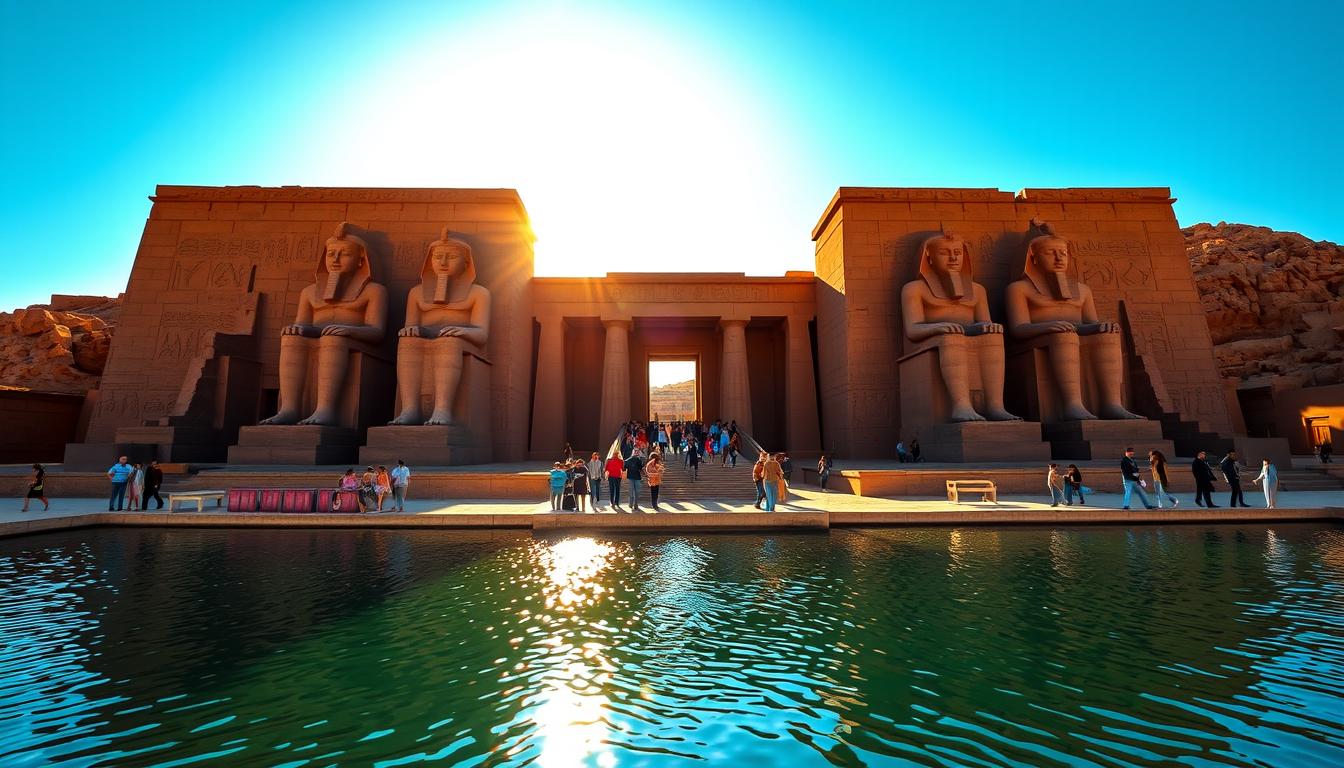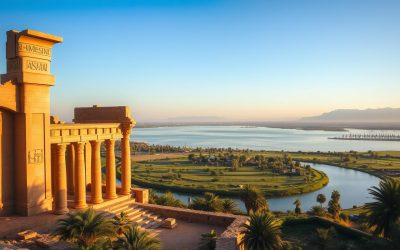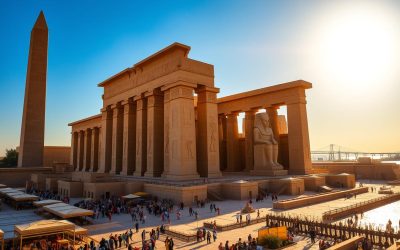Have you ever wondered what it’s like to stand in front of a monument that defies time and human ingenuity? The twin temples of Abu Simbel are not just ancient structures; they are a testament to the brilliance of ancient engineering and modern preservation efforts. Located on the banks of Lake Nasser, this iconic site is a must-visit for anyone exploring the wonders of Egypt.
These temples, dedicated to Ramses II and Queen Nefertari, were carved into the mountainside over 3,000 years ago. What makes them even more fascinating is their relocation in the 1960s to save them from flooding. This monumental effort involved cutting the temples into massive blocks and reassembling them 65 meters higher. Today, they stand as a symbol of international cooperation and historical preservation.
Whether you’re planning a day trip from Aswan or including it in a Nile cruise, Abu Simbel offers a unique blend of history, architecture, and awe-inspiring beauty. This guide will walk you through the best experiences, practical tips, and hidden gems to make your visit unforgettable.
Key Takeaways
- Discover the twin temples of Ramses II and Queen Nefertari, marvels of ancient architecture.
- Learn about the incredible relocation project that saved the temples from Lake Nasser’s waters.
- Plan your visit with expert tips on tours, flights, and the best times to explore.
- Experience the grandeur of the Great Temple and the intimate beauty of Nefertari’s temple.
- Understand the historical and cultural significance of this UNESCO World Heritage Site.
Introduction: Discovering the Magic of Abu Simbel
Step into a world where ancient history and modern engineering collide in a breathtaking display. The twin temples, carved into the mountainside over 3,000 years ago, are a testament to human ingenuity and perseverance. Their relocation in the 1960s, a monumental effort to save them from rising waters, adds another layer of fascination to this UNESCO World Heritage Site.
This guide will take you on a journey through the historical significance, architectural marvels, and practical tips for visiting this iconic location. Whether you’re planning a day trip from Aswan or including it in a Nile cruise, you’ll find everything you need to make your visit unforgettable.
The temples, dedicated to Ramses II and Queen Nefertari, are more than just structures; they are symbols of cultural pride and international cooperation. Their grandeur continues to inspire travelers and historians alike, offering a glimpse into the past while standing as a beacon of preservation efforts.
Here’s what you’ll discover in this guide:
- The captivating history behind the temples and their relocation.
- Detailed insights into the architectural layout and symbolism of the site.
- Practical advice on planning your trip, from transportation to the best times to visit.
- How to integrate this experience into a broader Egypt itinerary.
“Abu Simbel is not just a destination; it’s a journey through time, culture, and human achievement.”
Prepare to be amazed by the beauty and significance of this hidden treasure. Whether you’re a history buff, an architecture enthusiast, or simply a curious traveler, this site promises an experience like no other.
Abu Simbel, Egypt: Best Things to Do – Top Picks
Immerse yourself in the grandeur of a site that has captivated travelers for centuries. The twin temples here are more than just ancient structures; they are masterpieces of art and engineering. Dedicated to Ramses II and Queen Nefertari, these rock-cut marvels are a must-see for anyone exploring this region.
The Great Temple of Ramses II is the star attraction. Its colossal statues and intricate carvings tell stories of power and divinity. Nearby, the smaller temple of Nefertari offers a more intimate experience, showcasing the queen’s significance in history. Both temples are rich in symbolism and detail, making them a feast for the eyes and mind.
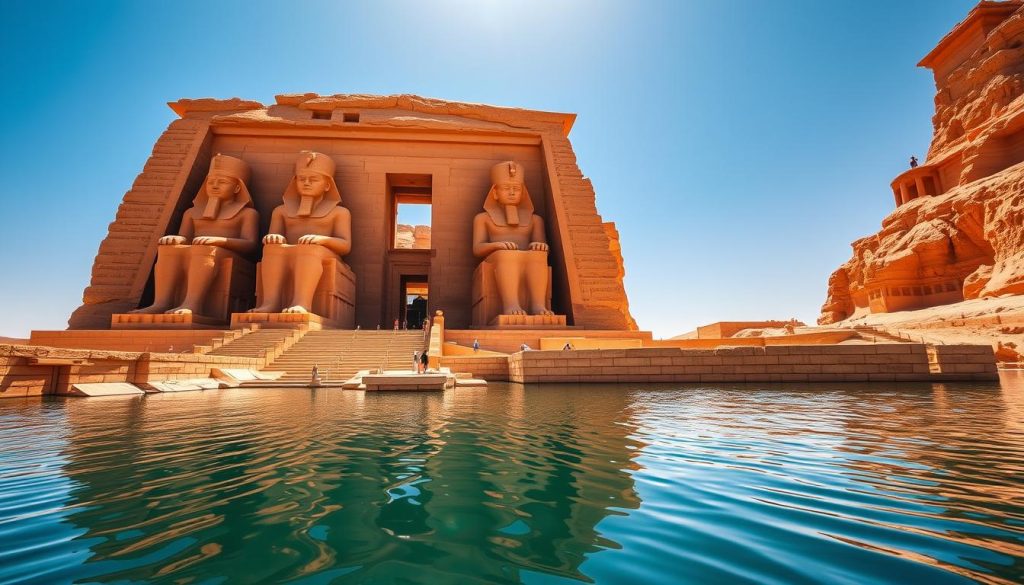
One of the most magical moments to experience is the solar alignment. On specific dates, sunlight illuminates the inner sanctuary, highlighting the craftsmanship of ancient builders. Timing your visit to witness this phenomenon can make your trip even more memorable.
Here are some top activities to enhance your experience:
- Explore the detailed reliefs and hieroglyphs that adorn the temple walls.
- Learn about the relocation project that saved these monuments from flooding.
- Capture stunning photos of the massive statues at sunrise or sunset.
- Take a guided tour to gain deeper insights into the site’s history and significance.
“The temples of Abu Simbel are not just relics of the past; they are living stories of human achievement.”
Whether you’re a history enthusiast or simply curious, this site offers something for everyone. Plan your visit with care, and you’ll leave with memories that last a lifetime.
Historical Significance and the Relocation Story
Discover the story behind one of the world’s most remarkable feats of ancient and modern engineering. The twin temples here are not just architectural wonders but also symbols of human perseverance and ingenuity. Their journey from the 13th century BC to the modern era is a tale worth exploring.
The Legacy of Ramses II
Ramses II, one of Egypt’s most powerful pharaohs, commissioned the construction of these temples as a testament to his reign. Built between 1264 and 1244 BC, they were designed to showcase his military victories and divine status. The colossal statues at the entrance, standing over 65 feet tall, depict him as a god-king, immortalizing his legacy.
The intricate carvings and hieroglyphs inside the temple celebrate his triumph at the Battle of Kadesh. These details not only highlight his achievements but also serve as propaganda, reinforcing his authority and divine connection.
The UNESCO Rescue Operation
In the 1960s, the construction of the Aswan High Dam threatened to submerge the temples under the rising waters of Lake Nasser. To save this cultural treasure, UNESCO launched an unprecedented rescue mission. Over four years, the temples were carefully cut into massive blocks, each weighing up to 30 tons, and reassembled 65 meters higher on a man-made mountain.
This monumental effort involved engineers, archaeologists, and workers from around the world. It stands as a shining example of international cooperation and the importance of preserving our shared heritage.
“The relocation of the temples is a testament to what humanity can achieve when we work together to protect our history.”
Today, the temples continue to inspire awe and admiration. They are a reminder of both the grandeur of ancient civilizations and the power of modern innovation. Whether you’re a history enthusiast or a curious traveler, this site offers a unique glimpse into the past and the efforts to preserve it.
Exploring the Majestic Temples of Ramses II and Nefertari
Step back in time and witness the grandeur of two iconic temples that tell stories of power and devotion. These ancient structures, carved into the mountainside, are more than just architectural marvels—they are symbols of a civilization’s legacy. Together, they offer a glimpse into the lives of a pharaoh and his queen, showcasing their influence and the artistry of their time.
Temple of Ramses II: Grandeur and Propaganda
The Great Temple of Ramses II is a testament to his reign and divine status. Four colossal statues of the pharaoh guard the entrance, each standing over 65 feet tall. These imposing figures were designed to awe visitors and reinforce his authority. Inside, intricate carvings and hieroglyphs depict his military victories, particularly the Battle of Kadesh.
This temple wasn’t just a place of worship—it was a statement of power. Every detail, from the alignment of the sanctuary to the placement of statues, was carefully planned to project his image as a god-king. It’s a masterpiece of ancient propaganda, blending art and politics in a way that still resonates today.
Temple of Nefertari: A Queen’s Tribute
Just a short walk away, the smaller temple dedicated to Queen Nefertari offers a different perspective. This structure is one of the few in ancient history built to honor a queen. Its design reflects her importance as Ramses II’s chief wife and a symbol of divine femininity.
The temple’s facade features statues of the queen alongside the pharaoh, a rare depiction of equality. Inside, the carvings and reliefs celebrate her role in religious ceremonies and her connection to the goddess Hathor. It’s a quieter, more intimate space compared to the grandeur of Ramses II’s temple, but no less significant.
When visiting, take time to notice the subtle differences in decoration and layout. The Temple of Ramses II emphasizes power and dominance, while Nefertari’s temple highlights grace and partnership. Together, they provide a fascinating insight into the dynamics of family and leadership in ancient times.
“These temples are not just relics of the past—they are stories carved in stone, waiting to be discovered.”
Inside the Temples: Architectural Layout and Symbolism
Uncover the secrets of ancient craftsmanship as you step inside the temples, where every detail tells a story of power and divinity. The interior design is a masterpiece of artistry and engineering, blending religious symbolism with practical construction techniques. From the towering columns to the celestial alignment, each element reveals the ingenuity of the builders.
The Hypostyle Hall and Bas-Reliefs
The hypostyle hall is one of the most striking features of the temple. It’s filled with massive columns, each intricately carved with scenes of military victories and religious rituals. These carvings, known as bas-reliefs, depict key moments from the reign of Ramses II, including the famous Battle of Kadesh.
Every scene in the hall has a symbolic meaning. The columns represent the pharaoh’s connection to the gods, while the carvings emphasize his power and divine status. As you walk through, take time to observe the details—each tells a part of the story.
The Sanctuary’s Celestial Alignment
Deep within the temple lies the sanctuary, a carefully engineered space where sunlight plays a magical role. On specific dates, the sun aligns perfectly with the inner sanctum, illuminating the statues of the gods. This phenomenon occurs twice a year, on February 22 and October 22, marking significant events in the pharaoh’s life.
This alignment is a testament to the ancient builders’ understanding of astronomy and their ability to integrate it into their architecture. It’s a breathtaking sight that highlights the temple’s spiritual and scientific significance.
Here are some tips to make the most of your visit:
- Explore the hypostyle hall to admire the detailed carvings and understand their symbolism.
- Plan your visit around the celestial alignment dates for a truly unique experience.
- Use a guide to gain deeper insights into the temple’s layout and history.
“The temples are not just structures; they are stories carved in stone, waiting to be discovered.”
Whether you’re a history enthusiast or a curious traveler, the interior of these temples offers a fascinating journey into the past. Take your time to explore and appreciate the artistry and symbolism that make this site a true wonder.
Planning Your Visit: Essential Tips and Practical Advice
Prepare for an unforgettable journey with these essential tips to make your visit seamless. Whether you’re traveling from Aswan or including this site in a broader itinerary, a little preparation goes a long way. From packing smart to timing your trip perfectly, here’s everything you need to know.
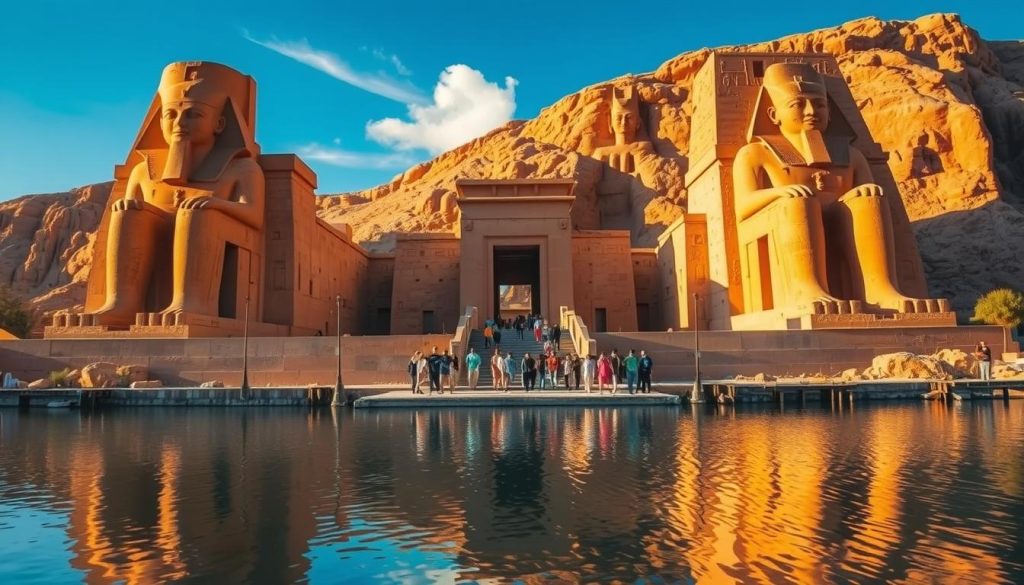
What to Pack and When to Visit
Packing for this destination requires careful consideration. The desert climate means you’ll need sunscreen, a wide-brimmed hat, and plenty of water. Comfortable walking shoes are a must, as you’ll explore the site on foot. A reusable water bottle is also a smart addition to stay hydrated.
The best time to visit is during the cooler months, from November to March. Avoid the scorching summer heat, which can make exploring uncomfortable. Early mornings or late afternoons are ideal for avoiding crowds and enjoying the site’s beauty in softer light.
Transportation and Site Navigation
Getting here is part of the adventure. Flights from Aswan are quick and convenient, while bus tours offer a budget-friendly option. Once you arrive, a concrete path leads to the temple entrance, making navigation easy. Be prepared for a short walk, but the views along the way are worth it.
Booking a guided tour can enhance your experience. A knowledgeable guide provides insights into the history and significance of the site, enriching your visit. If you prefer exploring independently, audio guides are also available.
Making the Most of Your Trip
Plan your visit to coincide with the solar alignment if possible. This phenomenon occurs twice a year and is a breathtaking sight. Arriving early ensures you have ample time to explore without feeling rushed.
Don’t forget to check out nearby attractions. The surrounding area offers stunning views of Lake Nasser and opportunities to learn about local culture. Combining your visit with other nearby sites can make your trip even more memorable.
“A well-planned visit ensures you leave with lasting memories and a deeper appreciation for this iconic site.”
How to Get to Abu Simbel from Aswan
Planning your journey to this iconic site is easier than you might think, with multiple travel options to suit your needs. Whether you prefer speed, comfort, or affordability, there’s a way to make your trip seamless. Here’s a breakdown of the best ways to reach this destination from Aswan.
Travel Options: Air, Bus, and Private Tours
Getting to the temples from Aswan is straightforward, with three main options: flights, bus tours, and private transfers. Each has its advantages, depending on your budget and schedule.
Flights are the quickest option, taking just 45 minutes one-way. Egypt Air offers two round-trip flights daily, except on Sundays. While more expensive, starting at $150 per person, this option saves time and is ideal for those with limited schedules.
Bus tours are a budget-friendly choice, costing around $70 per person. The journey takes 3-4 hours each way, but it’s a great way to enjoy the desert scenery. These tours often include air-conditioned transportation and a guide, making them a convenient option for many travelers.
Private transfers offer flexibility and comfort. Hiring a driver costs between 3,500 and 3,800 EGP for a day trip. This option is perfect for groups or those who prefer a personalized experience.
| Option | Duration | Price | Best For |
|---|---|---|---|
| Flight | 45 mins | $150+ | Time-conscious travelers |
| Bus Tour | 3-4 hours | $70 | Budget travelers |
| Private Transfer | 2.5-3 hours | 3,500-3,800 EGP | Groups or personalized trips |
When choosing your travel method, consider your budget, time constraints, and comfort preferences. Booking in advance is highly recommended, especially during peak seasons like Christmas and Easter.
“The journey to the temples is as much a part of the experience as the destination itself. Choose wisely, and you’ll start your adventure on the right foot.”
No matter which option you pick, you’re in for an unforgettable experience. Plan ahead, pack smart, and get ready to explore one of the world’s most remarkable sites.
Experiencing Local Culture and Nearby Attractions
Dive into the vibrant culture of southern Egypt and discover the rich heritage of the Nubian people. Beyond the awe-inspiring temples, this region offers a chance to connect with a community that has preserved its traditions for centuries. Exploring local culture adds depth to your journey, making it more than just a sightseeing trip.

Insights into Nubian Heritage
The Nubian people have a long and proud history, deeply intertwined with the Nile River. Their vibrant culture is reflected in their colorful homes, traditional music, and unique crafts. Visiting a Nubian village near Aswan is a must for anyone looking to experience this heritage firsthand.
Here are some highlights of Nubian culture you can explore:
- Traditional Music and Dance: Enjoy performances that showcase the rhythms and melodies of Nubian culture.
- Handmade Crafts: Browse local markets for pottery, jewelry, and textiles made by skilled artisans.
- Local Cuisine: Savor dishes like ful medames and ta’ameya, which offer a taste of Nubian flavors.
Nearby Attractions Celebrating Nubian Heritage
Several sites near Aswan celebrate Nubian culture and history. The Nubian Museum is a treasure trove of artifacts, offering insights into the parallel histories of Nubia and ancient Egypt. Another must-visit is the Aswan Market, where you can interact with locals and shop for unique souvenirs.
For a more immersive experience, consider a boat ride along the Nile. This allows you to see traditional Nubian villages from the water and gain a deeper appreciation for their way of life.
“Exploring Nubian culture is not just about learning history—it’s about connecting with a living, breathing community that continues to thrive today.”
Practical Tips for Cultural Exploration
To make the most of your cultural experience, plan ahead. Here are some tips:
- Guided Tours: Join a local guide who can provide insights into Nubian traditions and history.
- Timing: Visit villages and markets in the morning or late afternoon to avoid the midday heat.
- Respect: Always ask for permission before taking photos of people or their homes.
By immersing yourself in Nubian culture, you’ll gain a richer understanding of this region and its people. It’s an experience that will stay with you long after your trip ends.
Integrating Abu Simbel into Your Egypt Itinerary
Crafting the perfect Egypt itinerary can be a rewarding challenge, especially when including iconic destinations. This site is a must-see, but it’s also part of a larger journey through history and culture. With careful planning, you can seamlessly add it to your travel plans without feeling rushed.
Day Trips and Multi-Site Tours
One of the easiest ways to visit is through a day trip from Aswan. Flights take just 45 minutes, making it a convenient option for those short on time. Alternatively, bus tours offer a budget-friendly way to explore, with the added benefit of enjoying the desert scenery along the way.
For a more comprehensive experience, consider a multi-site tour that includes Luxor and other historic locations. These tours often combine visits to the Valley of the Kings, Karnak Temple, and the Nile River, creating a well-rounded itinerary. Here are some advantages of multi-site tours:
- Efficiency: Maximize your time by visiting multiple landmarks in one trip.
- Expert Guidance: Learn from knowledgeable guides who provide deeper insights.
- Convenience: Transportation and logistics are handled for you.
Expert Recommendations for Seamless Travel
Timing is key when planning your visit. Early mornings or late afternoons are ideal for avoiding crowds and enjoying cooler temperatures. If possible, align your trip with the solar alignment dates for a truly magical experience.
Here are some expert tips to ensure a smooth journey:
- Book in Advance: Flights and tours can fill up quickly, especially during peak seasons.
- Pack Smart: Bring sunscreen, a hat, and plenty of water for the desert climate.
- Combine Experiences: Pair your visit with cultural activities, like exploring Nubian villages or cruising the Nile.
“A well-planned itinerary ensures you make the most of your time, balancing history, culture, and relaxation.”
Whether you’re a history enthusiast or a casual traveler, integrating this site into your Egypt itinerary is a decision you won’t regret. With the right planning, you’ll create memories that last a lifetime.
Traveler Reviews and Expert Recommendations
Hearing firsthand experiences from travelers can make your journey even more meaningful. Reviews from those who’ve visited before offer valuable insights into what makes this destination unforgettable. Whether it’s the architectural grandeur or the atmospheric light shows, past visitors often describe their trip as life-changing.
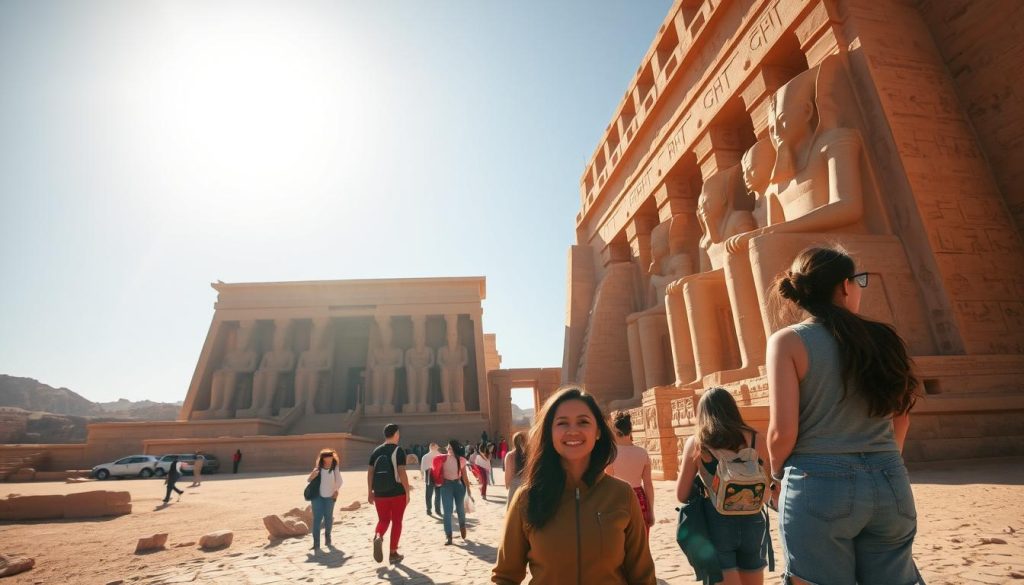
What Past Visitors Loved
Many travelers highlight the architectural marvels of the temples. The colossal statues and intricate carvings leave a lasting impression. One reviewer shared, “Standing in front of the temple felt like stepping back in time. The sheer scale and detail are breathtaking.”
Another common theme is the solar alignment phenomenon. Visitors who timed their trip to witness this event described it as magical. “Seeing the sunlight illuminate the inner sanctuary was a once-in-a-lifetime experience,” said one traveler.
Top Tips from Local Guides
Local guides emphasize the importance of early planning. Booking tours and flights in advance ensures a smoother experience. One guide advised, “Arrive early to avoid crowds and enjoy the site in the softer morning light.”
Guided tours are highly recommended for deeper insights. A local expert shared, “Having a guide helps you understand the history and symbolism behind every detail. It transforms your visit from sightseeing to storytelling.”
“The temples are not just a destination; they’re a journey through history, culture, and human achievement.”
By learning from others’ experiences and following expert advice, you can make the most of your trip. Whether it’s your first visit or a return journey, these insights will help you create memories that last a lifetime.
Conclusion
Exploring the wonders of ancient history offers a unique glimpse into human achievement. The temples stand as a testament to the brilliance of ancient engineering and modern preservation. From their historical significance to the intricate carvings, every detail tells a story of power and divinity.
This guide has provided insights into planning your visit, from transportation tips to the best times to explore. Whether you’re a history enthusiast or a curious traveler, the experience promises to be unforgettable. Use these tips to craft a personalized trip that suits your interests and schedule.
Careful planning ensures you make the most of your time, balancing history, culture, and relaxation. The temples are more than just structures; they are stories carved in stone, waiting to be discovered. Take the time to explore and appreciate the marvels of ancient history.
The above is subject to change.
Check back often to TRAVEL.COM for the latest travel tips and deals.
Here are some Tours & Sightseeing suggestions that might pique your interests!
